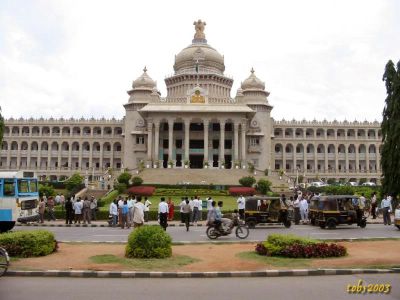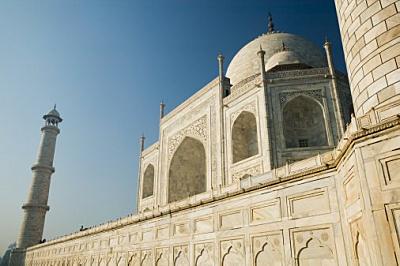
The colours of the Taj
Taj Mahal changes its moods with the seasons and the different times of the day. At dawn, the marble has a delicate bloom in shell pink, by noon it glitters majestically white, turning to a soft pearly grey at dusk. On full-moon away against the star-spangled sky. Monsoon clouds give it a moody blue tint and it appears and disappears like a mirage in the drifting mists of winter.
It can be solid and earthbound, fragile and ethereal, white, amber, grey and gold. The many faces of Taj Mahal display the seductive power of architecture at its best.

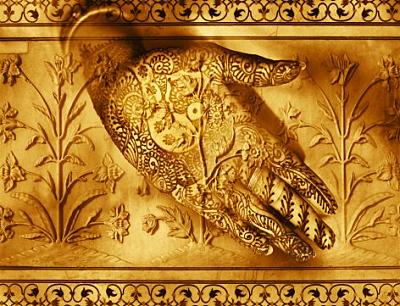
The Main Building
The tomb stands on a marble plinth six-metres high. The four minarets at each corner beautifully frame the tomb. The plinth stands on a high standstone platform and at the far ends of this base are two identical sandstone structures, a mosque to the west and its jawab, or echo, to the east. This was the mehman khana or guesthouse. Thus, the main building is not just of great size but beautifully proportioned and balanced in design.
The octagonal central hall has four smaller octagonal halls round it and is decorated with magnificent inlay and dado panels done in high relief. The bulbous, perfectly-balanced double dome rises to a height of 45 metres and the four chhattris flanking and balancing the high drum give it added height. Taj Mahal rises 75 metres high and is, in fact, taller than the Qutb Minar.
An ornate marble screen, carved so fine that it almost has the texture of lace surrounds the cenotaphs in the central hall. However, as was the tradition during Mughal times, the actual graves lie in an underground crypt directly below the cenotaphs.
Wow!!! Kuldip

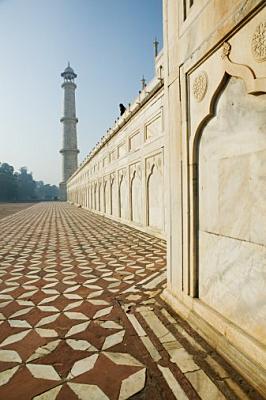
The bejewelled Palace
Shahjahan's two biggest passions were architecture and jewellery and both are reflected in the Taj Mahal. He visualised a building in marble and then had it decorated with semi-precious stones inlaid with the delicacy of handcrafted jewellery. Marble in purest white was brought from Makrana in Rajasthan, yellow marble and rockspar from the banks of the Narmada river, lack marble from Charkoh and red sandstone from Sikri. For the intricate pietra dura the finest gems were collected - crystal and jade from China, lapis lazuli and sapphires from Sri Lanka, jasper from Punja, carnelian from Baghdad and turquoise from Tibet.
Yemen sent agates, the corals came from Arabia, the garnets from Bundelkhand, onyx and amethyst from Persia. Mumtaz Mahal's final resting-place was ornamented like a queen's jewel-box.


A flawless architectural creation
For centuries, the Taj Mahal has inspired poets, painters and musicians to try and capture its elusive magic in word, colour and son. Since the 17th century, travellers have crossed continents to come and see this ultimate memorial to love, and few have been unmoved by its incomparable beauty.
Taj Mahal stands in the city of Agra, in the northern Indian state of Uttar Pradesh, on the banks of the Yamuna river. It was built in the memory of the beautiful Arjumand Bano Begum, who won the heart of a Mughal prince. She was married at 21 to Emperor Jahangir's third son Prince Khurram and stayed loyally by his side through good times and bad: in the luxurious royal palaces of Agra as well as the transient tents of war camps.


Bogmolo Beach - a small-scale beach resort, reasonably safer site for swimming, quite good eating joints and shopping options.
Miramar Beach - just 3-km away from the capital city of Panjim.
Pololem Beach - a favourite beach destination, crescent shaped bay, swaying curtain of coconut palms, irresistibly photogenic, beautiful beach huts.
Vagator Beach - cool rural area, no big shopping complexes.
Varca Beach - community of Christian fisher folk, palm thatched long houses, grassy dunes.

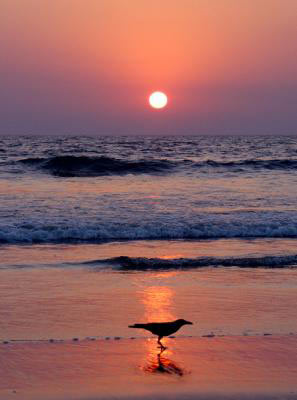
Benaulim Beach - sea is safe for swimming generally jellyfish-free, village area near beach side boasts a few serviceable bars and restaurants, various culinary delights of the seafood, most succulent, competitively priced seafood in Goa.
Cavelosim Beach - last major settlement in southwest Salcete, visit to Mabor, South Goa largest, and most obtrusive, package tourist enclave.
Chapora Beach - a lot busier than most north coast villages, dependent on fishing and boat building, many regular cafes and restaurants
Condolim Beach - good options to stay offering better value, a good first stop to head North.

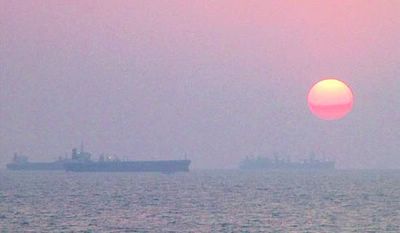
The world famous beaches of Goa are the highlights of travel in this state, making Goa the premier beach vacation destination. The first beach stop over in Goa is Anjuna beach also famous for its flea market and rave parties, then the Baga and Dona Paula beaches that can make any beach holiday a memorable one. 100-km long coastline gives an enthusiastic beach lover an opportunity to discover new secluded beach sites every day.
Anjuna Beach - fluorescent painted palm trees and infamous full moon parties, 8 km west of Mapusa, most "alternative", the dancing and lying on the beach, famous flea market.
Baga Beach - watch the sun go down in isolation, 10-km west of Mapusa, basically an extension of Calangute wooded headland.
Dona Paula - fine view of the Marmagao Harbour nestled on the south side of the headland that divides the Zuari and Mandovi estuaries, former fishing village, today's commercialised beach resort, idyllic spot to relax and sunbathe.
Calangute Beach - Goa's busiest and most commercialised resort. During the 70's and 80's this peaceful fishing village became the favourite haunt of the hippies.


